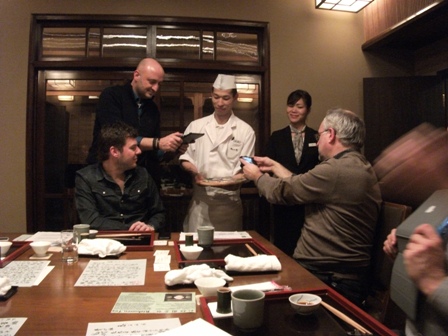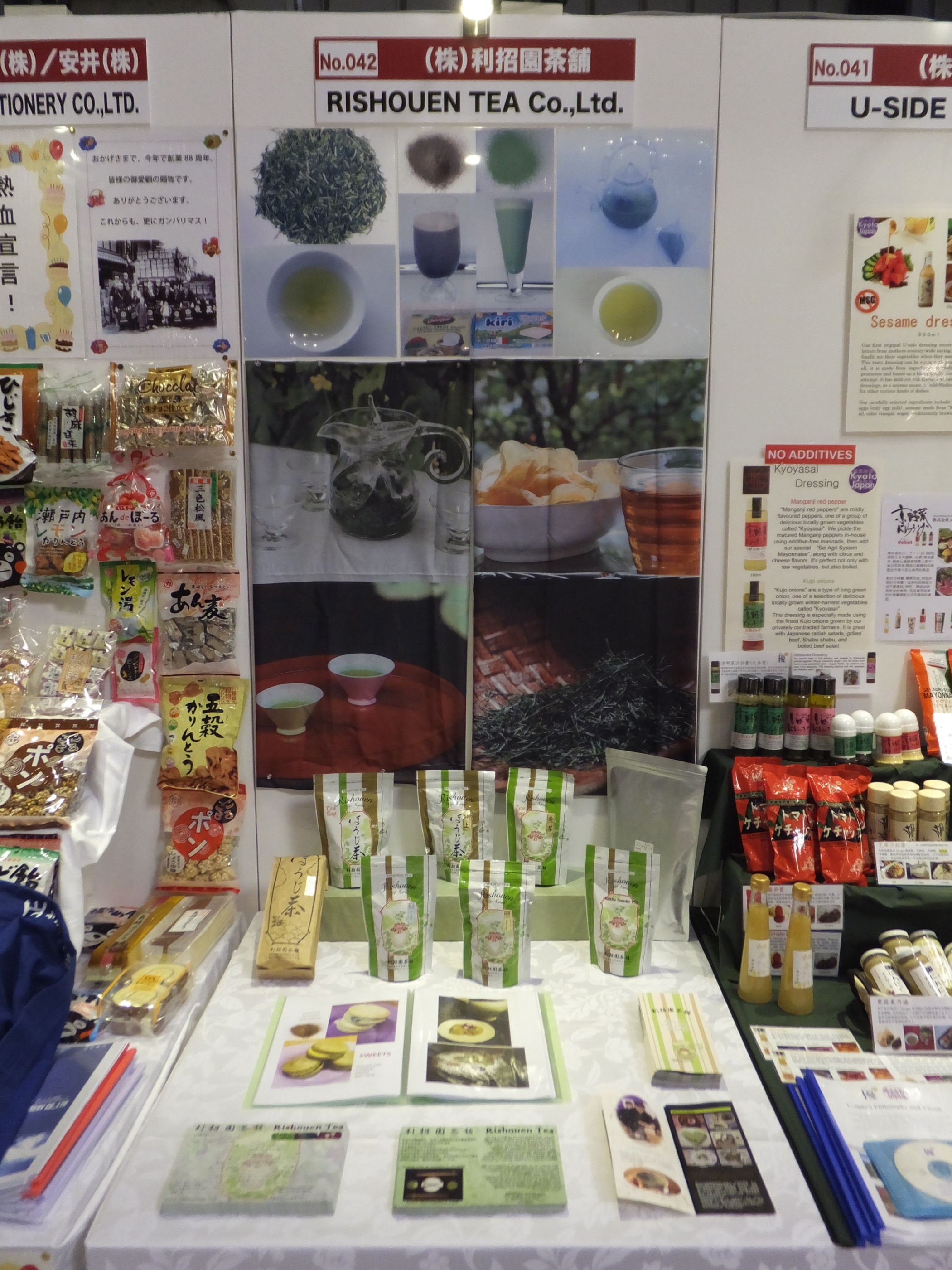Rendez-vous with the Stars of the Belgian Cuisine
Saturday 18th January 2014
1. Presentation
Saturday 18th January 2014, on the evening, the enterprise Rishouentea had the huge privilege to be able to meet three great chefs who came from Belgium: Gert de Mangeleer, Viki Geunes, David Martin and Willem Asaert, a journalist expert in cookery. The meeting took place in the restaurant Wakuden Muromachi located in the center of Kyoto, renowned for its elaborated cooking which brings touches of modernity to traditional dishes and its refined atmosphere, the perfect environment in order to discuss with those persons fascinated by flavor.
Little tour of the very colorful guests whose sit at the same table than us:
Gert de Mangeleer is the chef of the three stars restaurant Hertog-Jan in Bruges where he works in tandem with Joachim Boudens, elected wine waiter of the year in 2012. The two partners have their own farm where they grow hundreds of vegetables and fine herbs and even plan to move the restaurant there, allowing their clients to appreciate the flavor, the perfume but also the view of all the seasonal products meticulously selected and prepared in the unique dishes of the master cook.
Viki Geunes is the chef of the two stars restaurant ‘tZilte in Anvers where he works in an open kitchen, giving to the bystanders the chance to taste the pleasures of culinary action without perturbing their tranquility. The place, located in altitude, offers in exterior an impregnable view of the city and its monuments and in interior a remarkable contemporary decoration. The cooking is innovative while respecting the product.
David Martin is the chef of the brasserie La Paix in Bruxelles, the only one in the whole country to possess a star in the Michelin guidebook. Forgotten are the unfounded prejudices that people usually have when hearing the name brasserie, La Paix clears all the conditions needed to be a great restaurant, with the conviviality in prime. Lover of the terroir products which marked his childhood, he can put them in service of a historical cooking that he is renewing without denaturing it. He also animates a short gastronomic emission on the radio.
Willem Asaert is journalist expert in cookery who writes for many magazines and has also published many novels on the subject, one of them in collaboration with Johan Segers, the patriarch of the Belgian gastronomy. His dedicated and detailed work earned him a lot of prices, in particular in the Gourmand World Cookbook Awards.
At their sides, represented by Kagata Kouji and Kagata Mie, the enterprise Rishouentea, an estimated distributor of teas which counts a total 27 stars in the Michelin guidebook, is the official supplier of many famous restaurants including Wakuden and, directly linked to this meeting, exports in Europa. And as the last member of this evening, myself, Ducollet Cyril, the translator and interpreter in charge of the international sales in Rishouentea.
2. Development
While enjoying an exquisite meal and drinking high quality tea, we approach many different subjects with the three chefs who came to Japan in search of new skills, flavors and inspirations: the association between tea and Japanese cooking and then with Belgian cooking, the marriage between cheese and green tea which is the actual project of Rishouentea, and at the end the sparkling tea or Utatamacha, the original creation of Kagata Kouji.
After a brief greeting, we attacked immediately the core of the subject with the welcome tea (omukae no ocha), a Gyokuro from the year 23 of the Heisei era, infused by Mister Kagata himself and served lukewarm in order to only free the Umami flavor of the tea, that made a very strong impression with his taste, assimilated by our table companions to a sweet broth.
The welcome tea, besides the meaning expressed in his name, has three principal roles:
– Renewing the impression left inside the mouth and the brain by the flavor of the last food consumed, allowing everyone to begin the meal on the same start line.
– Training the brain and the taste buds, in other words, a warming-up in order to be in the best possible condition.
– Revitalizing the stomach and accelerating the secretion of the liver enzymes assuring the decomposition of the alcohol drunk after thanks to the catechin presents in the tea.
After drinking the Gyokuro Hana, we began the meal with Kaburamushi (steamed fishes with grated turnip on top), small dish only served during the coldest days of winter, and continued our culinary journey to the Haru no Nabe (saucepan of spring) and its bitter vegetables accompanied by a succulent meet, with in between, fishes (Hiuo, Buri, Moroco ou Hizakana), shellfishes (Awabi, Kaibashira) and shrimps (Kuruma Ebi). Between the dishes, the second infusion of Gyokuro, at high temperature, freeing his taste of Shibumi (astringency) but was easily drunk without perturbing the taste of the following ingredients according to our guests words, and also many infusions of Sencha Kaze, from the same year, and served hot. And drinking it while eating, a Houjicha (roasted tea).
The Gyokuro and Sencha drunk between the dishes allowed us to refresh our mouth and to appreciate entirely the richness of all the dishes flavors composing the menu, especially thought fort his occasion by the Wakuden’s chef, Mister Takimura, who gave it a particular meaning: beginning in winter with the Kaburamushi, the meal progress to the spring, symbolized of course by the saucepan of bitter vegetables but also the shellfishes, expressing the passage of time. That isn’t everything, the vegetable Kuwai, served at the end and normally eaten at the beginning of the year, refers to the sentiment of nostalgia or regret for all the good things that came to an end with the passage of time (nagorioshii). In Japanese cookery, the meaning given to the menu by the chef is the mark of his hospitality toward his clients.
Along with the dessert, we drank a weak Matcha (Ousu) named Kensou no Shiro, name given by Mister Kagata. “Ken” means gutters or more accurately the portion of suspended roof where they are and “sou” the windows, evoking together the view of the restaurant while “shiro” refers to the white nuance of the Matcha.
For the final we tested the marriage between cheese and sparkling tea with pieces of Taleggio and Le Mellois. This really amazing and successful experience is giving us the possibility to review the position of tea in the foreign cooking.
3. Conclusion
What can we say about this meeting in term of relationship between two very different culinary cultures? The three chefs declared it: obviously, they didn’t come to Japan in order to open a Japanese restaurant when they will be back in Belgium. No, if they traveled so far away it’s to see, learn the skills used by Japanese chefs and discover new sensations. On this last point, I think that our interests match. Moreover, they express the desire to use tea in their cooking, searching something different than the persisting image of Matcha with the sole evocation of the words “Japanese green tea”. Thus, these are open minded and curious people who gave us their opinion.
The main problem that comes to me is concerning the consumption of tea during the meal, between the dishes or while eating them, in place of wine. The differences of mores between Japan and Belgium, or France, are too important. It is inconceivable that tea takes the place of wine and the comparison between the two is, like it was said, very dangerous. However, the solutions to integrate the Japanese tea in the European cooking exist:
In the restaurant Hertog-Jan, cheese is served with three different wines, leaving the freedom of choice to the client. Why not gradually offer tea as an accompaniment to alcohol? Rather than taking the place of wine, the Japanese green tea can become its ideal partner. Furthermore, the affordable price for a good tea makes it accessible to more customers, a considerable asset in time of economy crisis. Not counting the presence of people who don’t drink alcohol, per choice or per obligation, and who had like a drink that can marry properly with their cheese or more simply with their food. Let’s not forget the lunch where the consumption of alcohol is lesser than during the dinner. The Japanese green tea would not take the place of wine but just come where it isn’t habitually present.
It is a long road in front of us but it holds the merit to be taken and the results that we will obtain at the end will depend of those who will have accompanied us.
This meal was a very instructive experience and the members of Rishouentea, including me, had a great time. Thanks to Gert de Mangeleer, Viki Geunes, David Martin and Willem Asaert for accepting to meet us and sharing their opinions.
I hope that I will have the chance to meet you again soon and I wish you all a good stay rich in culinary discovers in the land of the Rising Sun.





